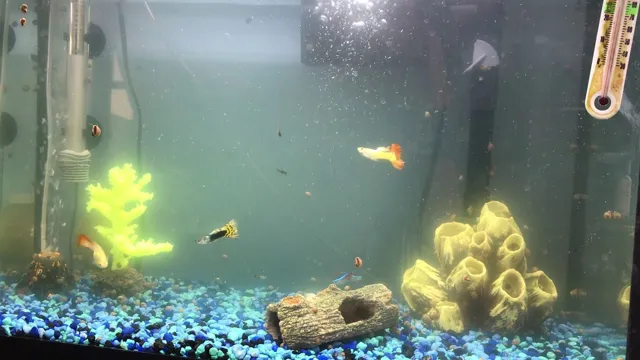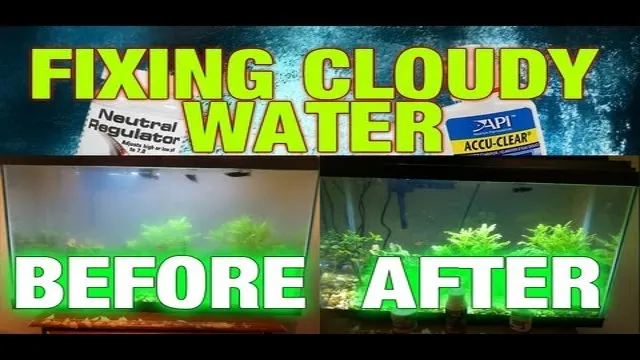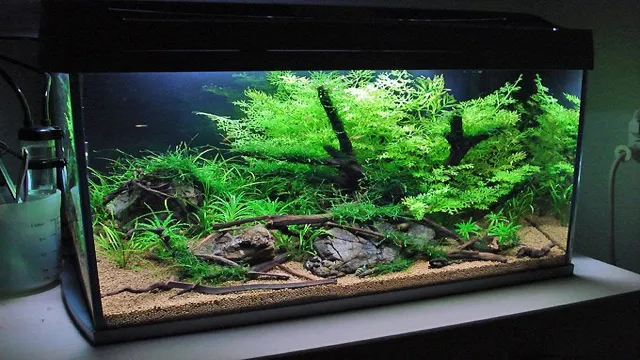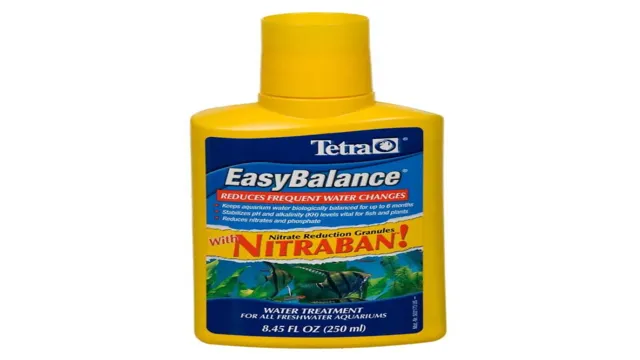How to Clear Cloudy Saltwater Aquarium Water: 6 Effective Tips for a Crystal Clear Tank

Do you dream of having crystal clear water in your saltwater aquarium? Cloudy water can be frustrating for any aquarist, but don’t worry! It’s a common problem that can be easily fixed with the right tips and tricks. In this blog, we will cover various methods that will help you clear cloudy saltwater aquarium water and get your aquarium looking as beautiful as you want it to be! Whether you’re a seasoned hobbyist or just starting out, these tips are easy to follow and will help you maintain a healthy and thriving saltwater aquarium. So, let’s dive in and find out how to get rid of cloudy water once and for all!
Identify the Cause of Cloudiness
If you’re struggling with cloudy water in your saltwater aquarium, identifying the cause should be your first step in clearing it up. One common culprit is an excess of organic waste or uneaten food in the tank. This can lead to a build-up of bacteria and other microorganisms that can cause the water to become hazy.
Another possible cause is improper filtration or overfeeding of the fish, which can also lead to a buildup of waste products in the water. In some cases, a sudden change in temperature or pH levels can also cause cloudiness. It’s important to investigate all of these potential causes to determine the best course of action for clearing up your aquarium water.
By addressing the root of the problem, you can ensure that your fish have a healthy and clear environment to thrive in.
Check Your Water Parameters
When it comes to cloudy water in your aquarium, it’s important to check your water parameters to identify the cause of the issue. One common cause of cloudy water is a bacterial bloom, which can occur when there is an excess of organic waste or nutrient buildup in the water. Testing the levels of ammonia, nitrites, and nitrates can give you a better understanding of the overall health of your water.
Another factor to consider is the pH level of the water, as fluctuations in pH can also cause cloudiness. By monitoring these levels and conducting regular water changes, you can prevent and address cloudy water in your aquarium. It’s important to ensure that your aquatic friends are living in a clean, healthy environment, and taking care of your water parameters is a crucial step in achieving that goal.

Examine Your Equipment
When it comes to identifying the cause of cloudiness in your aquarium, examining your equipment is a crucial step. Make sure your filters are clean and functioning properly. Over time, filters can become clogged with debris and other waste, leading to cloudy water.
Additionally, check your lighting setup. Bright light sources can encourage the growth of algae, which can make the water cloudy. Lastly, pay attention to your substrate.
If your gravel or sand is too fine, it can easily become stirred up and lead to cloudy water. By taking a close look at your equipment, you can identify the root cause of cloudiness and take the necessary steps to resolve it. Remember, prevention is key – maintaining proper equipment function and cleanliness can go a long way towards keeping your aquarium clear and healthy.
Steps to Clear Cloudy Water
If your saltwater aquarium water has turned cloudy, don’t panic! There are several steps you can take to clear it up. The first thing to do is examine your filtration system. Make sure it is properly sized and working efficiently.
Next, check your water parameters. High levels of ammonia, nitrite, or nitrate can cause cloudiness. Test your water regularly and perform water changes as needed to keep levels in check.
You may also want to try using a protein skimmer, which removes organic waste from the water and can help clear it up. Finally, consider adding some activated carbon to your filtration system. This powerful absorbent can help remove impurities from the water and leave it crystal clear.
By following these steps, you should be able to clear up your cloudy saltwater aquarium water and enjoy a beautiful, healthy tank once again.
Perform a Water Change
Performing a water change is the first solution you should try whenever your aquarium water is cloudy. This simple yet effective method refreshes the tank’s water, removes pollutants, and replenishes essential minerals. But how do you go about it? Firstly, prepare a clean bucket to hold the old water, a siphon hose, and the dechlorinating agent.
Switch off any electrical equipment and unplug them. Use the siphon to remove 10-20% of the water, careful not to disturb the gravel. Keep sucking until the water level reaches the desired level, typically 1-2 inches below the gravel.
Replace the old water with dechlorinated, clean water, filling up slowly to avoid causing disturbance. If your aquarium has delicate fish, replace only 10% of the water to avoid shock. Done right, a water change could clear your cloudy water within hours, giving your aquatic friends a healthier and happier home.
Clean Your Filter Media
Clean Your Filter Media Are you tired of staring at cloudy, murky water in your aquarium or pond? The cause of this problem is often a dirty filter media. Cleaning your filter media regularly is crucial for maintaining a healthy aquatic environment. The first step is to turn off the filtration system and remove the filter media.
Next, rinse the media thoroughly with warm water or gently scrub it with a brush. It’s important to never use soap or chemicals, as they can harm fish and other inhabitants in the water. If the filter media is extremely dirty, consider replacing it altogether.
Once you’ve cleaned the media, reinsert it into the filtration system and turn it back on. Voila – crystal clear water! By keeping a regular cleaning schedule, you can avoid cloudy water and ensure your aquatic life remains happy and healthy.
Scrub Decorations and Substrate
If you’re dealing with cloudy water in your aquarium, don’t worry – you’re not alone. Cloudiness can be caused by a variety of factors, including overfeeding, waste buildup, and bacterial growth. Fortunately, there are steps you can take to clear up the water and get your aquarium looking clear and healthy again.
One important step is to scrub any decorations or substrate that may be contributing to the cloudiness. This is especially important for substrate that has not been properly cleaned in a while. By removing any excess waste or debris, you can help kickstart the process of clearing up the water.
Additionally, regular water changes and proper maintenance can help prevent cloudiness from occurring in the first place. Remember, a healthy aquarium starts with clean, clear water, so don’t skimp on the necessary upkeep.
Preventative Measures to Avoid Future Cloudiness
If you’re tired of dealing with cloudy saltwater aquarium water, there are several preventative measures you can take to avoid this problem in the future. Firstly, make sure you’re not overfeeding your fish. Overfeeding can lead to excess waste and uneaten food, which can contribute to cloudy water.
Secondly, consider using a high-quality filtration system to keep the water clean and clear. Regular water changes can also help keep the water fresh and clear. Additionally, avoid overcrowding your tank, as too many fish or other creatures can lead to an imbalance in the ecosystem and contribute to cloudiness.
Lastly, be sure to monitor the water chemistry regularly to ensure it’s within the appropriate levels for your fish and other aquarium inhabitants. By taking these preventative measures, you can enjoy a crystal-clear saltwater aquarium without the frustration of cloudy water.
Establish Good Maintenance Habits
Cloudiness is something most of us dread when it comes to our aquariums. To avoid future problems, establishing good maintenance habits is crucial. One way to be proactive is to clean the aquarium regularly.
Dirty water and excess food particles can cause cloudiness. This can be prevented by cleaning the aquarium weekly by sucking out the debris, uneaten food, and waste. Another preventative measure is to avoid overfeeding your fish.
Overfeeding leads to more waste, creating uneaten food in the aquarium, which can cause cloudiness. Maintaining the filter system regularly can also help prevent cloudiness. The filter is like the lungs of the aquarium, cleaning out debris, excess food, and waste.
When it’s not functioning correctly, these particles accumulate and cause cloudiness. By changing the filter media once every four to six weeks, you guarantee that it is functioning properly. With these preventive measures, you’ll not only prevent cloudiness in your aquarium but help maintain a healthy environment for your aquatic life.
Limit Feeding and Overcrowding
Limit feeding and overcrowding can lead to cloudy water in your aquarium. Preventative measures to avoid future cloudiness include maintaining proper feeding habits and ensuring your fish have plenty of swimming space. Limit feeding your fish to small amounts a few times a day can help prevent overfeeding and subsequent waste buildup that can lead to cloudy water.
Additionally, avoid overcrowding your aquarium by following recommended stocking levels based on the size of your tank and the species of fish you have. Overcrowding can lead to increased waste production and poor water quality, which can cause cloudiness. By taking these preventative measures, you can enjoy a clear and healthy aquarium for years to come.
Conclusion and Final Thoughts
Clearing cloudy saltwater aquarium water may seem like a daunting task, but with a little elbow grease and determination, it can be achieved. Just remember to address the root cause of the cloudiness, whether it be bacteria buildup, overfeeding, or poor filtration, and to resist the urge to add quick fixes like chemicals or additives that can do more harm than good. In the end, a beautifully clear and healthy aquarium is well worth the effort, and your fish will thank you for it with their happy swims and playful splashes.
“
FAQs
What causes saltwater aquarium water to become cloudy?
Cloudy water in a saltwater aquarium can be caused by various factors such as overfeeding, inadequate filtration, excessive waste, and introduction of pollutants.
How can overfeeding affect the clarity of saltwater aquarium water?
Overfeeding can lead to excessive organic waste production that, in turn, can lead to bacterial growth, poor water quality, and ultimately cloudy water.
How important is water maintenance in preventing cloudy saltwater aquarium water?
Regular water maintenance, such as water changes, skimming, and checking water parameters, is crucial in preventing cloudy water and promoting a healthy aquatic environment.
Can using tap water affect the clarity of saltwater aquarium water?
Yes, using tap water can potentially introduce pollutants, chemicals, and minerals that can affect water clarity and harm the inhabitants of the aquarium.
Does inadequate lighting have any impact on cloudy saltwater aquarium water?
Yes, inadequate lighting can lead to the accumulation of organic and inorganic debris, which can cause reduced water quality and ultimately cloudy water.
Are there any DIY remedies to clear up cloudy saltwater aquarium water?
DIY remedies for clearing up cloudy water include using activated carbon, diatomaceous earth, filter floss/pads, and increasing water flow.
When should a professional be consulted for cloudy saltwater aquarium water?
If the issue persists despite proper maintenance and DIY remedies, it is recommended to consult with a professional aquarium service provider for a more in-depth diagnosis and treatment.






